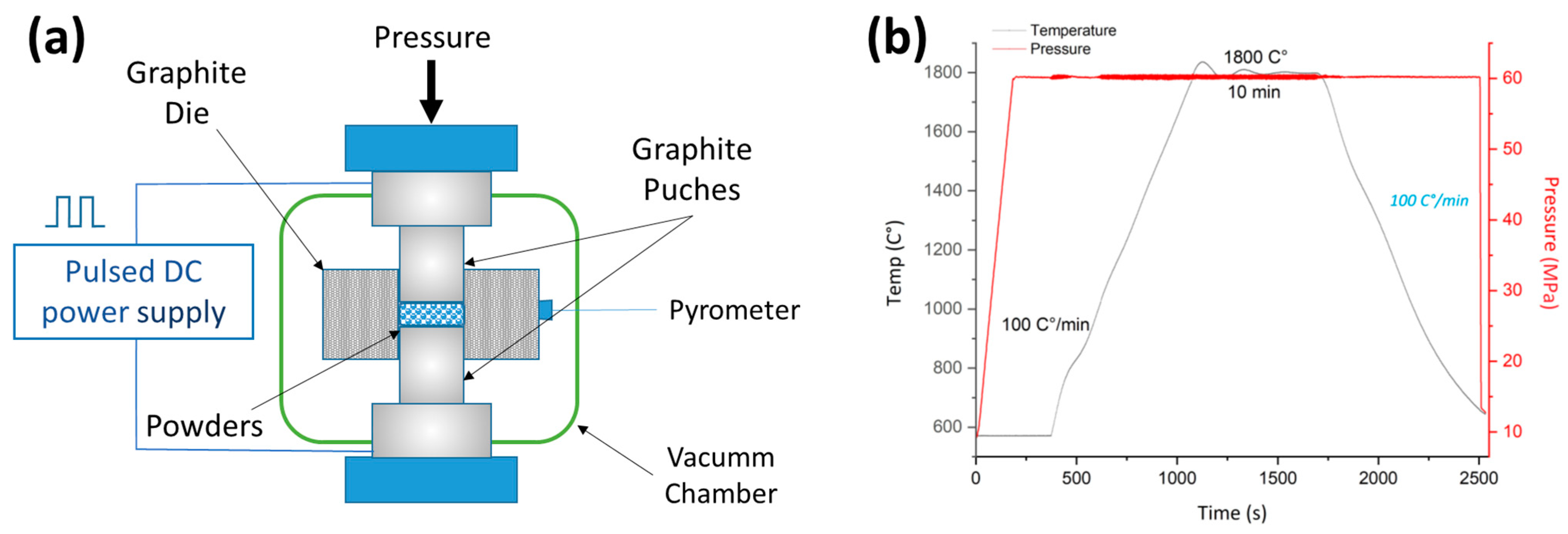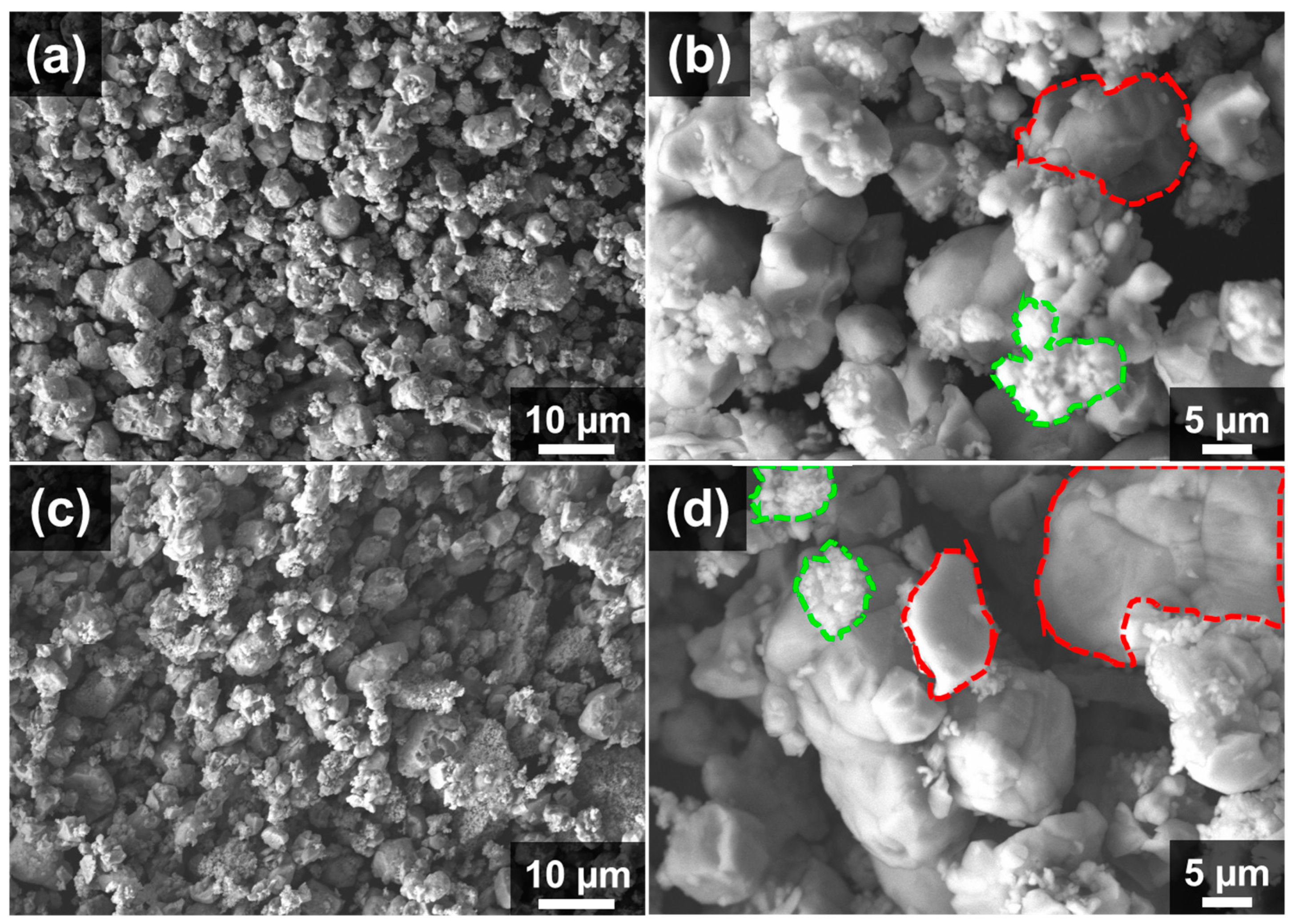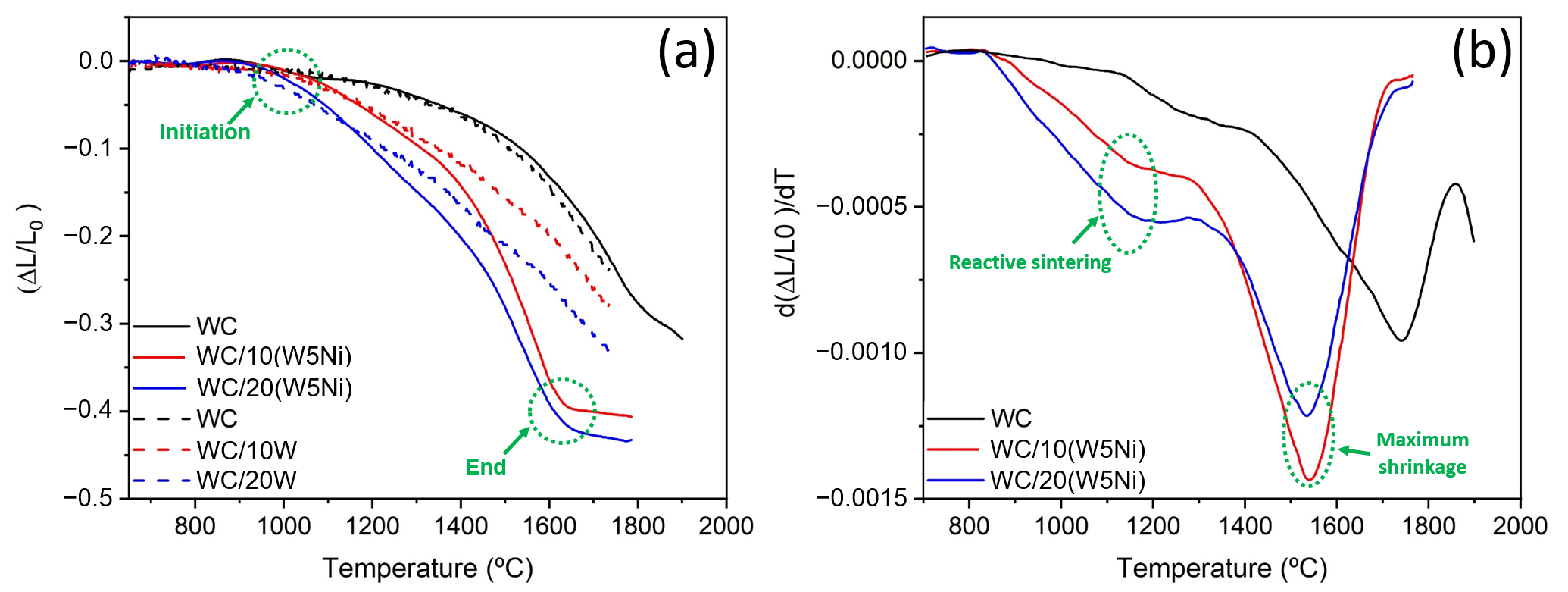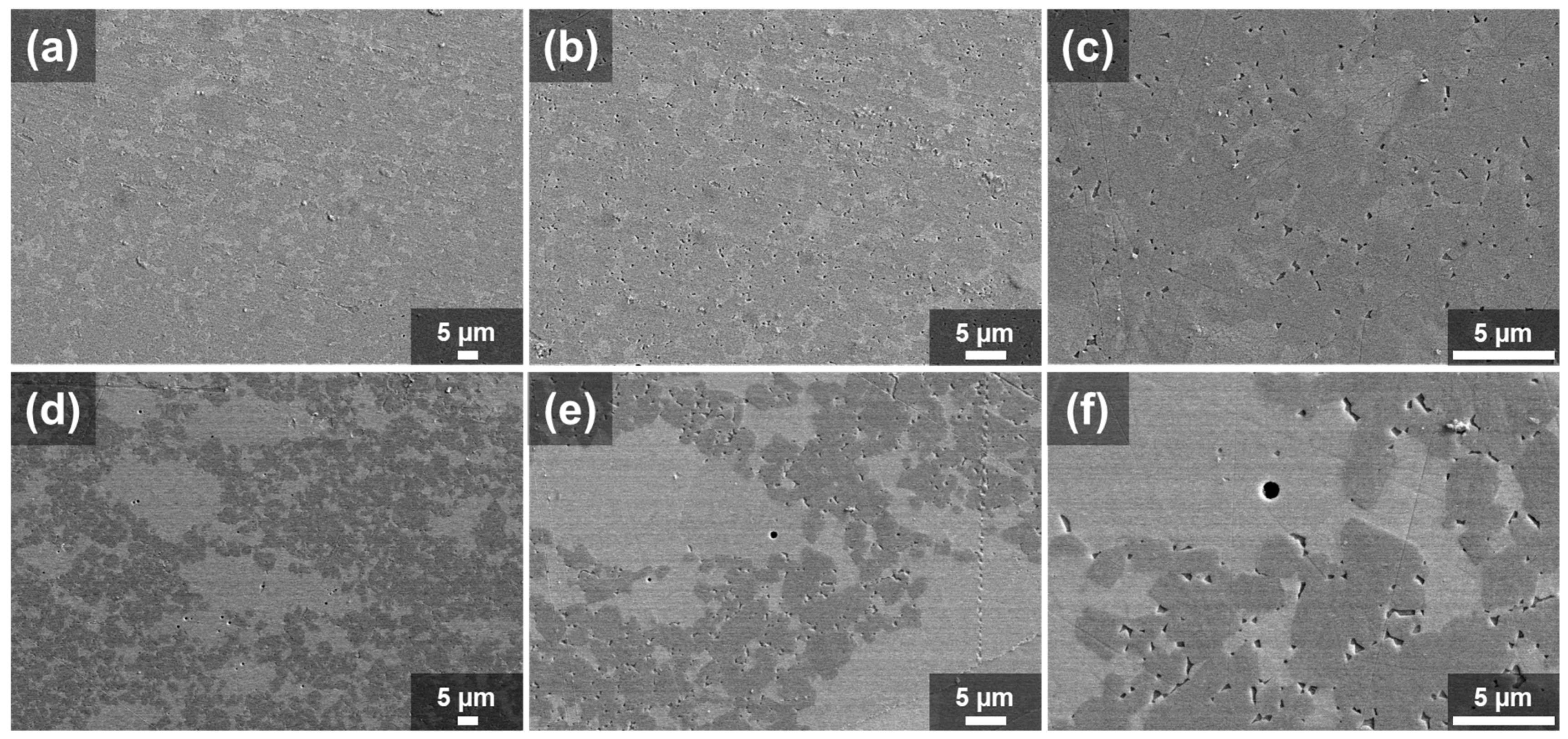Microstructural and Mechanical Characterization of Colloidal Processed WC/(W5Vol%Ni) via Spark Plasma Sintering
Abstract
:1. Introduction
2. Materials and Methods
2.1. Starting Powders and Mixture Compositions
2.2. Spark Plasma Sintering (SPS)
2.3. Microstructural and Mechanical Characterisation of the Sintered Samples
3. Results and Discussions
3.1. Powders Characterisation
3.2. Spark Plasma Sintering of the Composite Powders
3.3. Microstructural Characterisation of Sintered Samples
3.4. Mechanical Characterisation of Sintered Samples
4. Conclusions
Author Contributions
Funding
Institutional Review Board Statement
Informed Consent Statement
Data Availability Statement
Acknowledgments
Conflicts of Interest
References
- García, J.; Ciprés, V.C.; Blomqvist, A.; Kaplan, B. Cemented Carbide Microstructures: A Review. Int. J. Refract. Met. Hard Mater. 2018, 80, 40–68. [Google Scholar] [CrossRef]
- Heydari, L.; Lietor, P.F.; Corpas-Iglesias, F.A.; Laguna, O.H. Ti(C,N) and WC-Based Cermets: A Review of Synthesis, Properties and Applications in Additive Manufacturing. Materials 2021, 14, 6786. [Google Scholar] [CrossRef]
- Straumal, B.B.; Konyashin, I. Faceting/Roughening of WC/Binder Interfaces in Cemented Carbides: A Review. Materials 2023, 16, 3696. [Google Scholar] [CrossRef]
- Knaster, J.; Moeslang, A.; Muroga, T. Materials Research for Fusion. Nat. Phys. 2016, 12, 424–434. [Google Scholar] [CrossRef]
- Rowcliffe, A.F.; Garrison, L.M.; Yamamoto, Y.; Tan, L.; Katoh, Y. Materials Challenges for the Fusion Nuclear Science Facility. Fusion Eng. Des. 2018, 135, 290–301. [Google Scholar] [CrossRef]
- Rieth, M.; Dudarev, S.L.; De Vicente, S.G.; Aktaa, J.; Ahlgren, T.; Antusch, S.; Armstrong, D.E.; Balden, M.; Baluc, N.; Barthe, M.F.; et al. Recent Progress in Research on Tungsten Materials for Nuclear Fusion Applications in Europe. J. Nucl. Mater. 2013, 432, 482–500. [Google Scholar] [CrossRef] [Green Version]
- Wright, G.M. Hydrogenic Retention of High-Z Refractory Metals Exposed to ITER Divertor-Relevant Plasma Conditions. Nucl. Fusion 2010, 50, 055004. [Google Scholar] [CrossRef] [Green Version]
- Šestan, A.; Zavašnik, J.; Kržmanc, M.M.; Kocen, M.; Jenuš, P.; Novak, S.; Čeh, M.; Dehm, G. Tungsten Carbide as a Deoxidation Agent for Plasma-Facing Tungsten-Based Materials. J. Nucl. Mater. 2019, 524, 135–140. [Google Scholar] [CrossRef]
- Marshall, J.M.; Singh, G. Proton and Gamma Irradiation of Novel Tungsten Boride and Carbide Candidate Shielding Materials. Fusion Eng. Des. 2023, 193, 113667. [Google Scholar] [CrossRef]
- ASM International Handbook Committee. ASM Handbook. V. 7, Powder Metallurgy; ASM International: Materials Park, OH, USA, 2015; ISBN 9781627080893. [Google Scholar]
- Garcia-Ayala, E.M.; Tarancon, S.; Ferrari, B.; Pastor, J.Y.; Sanchez-Herencia, A.J. Thermomechanical Behaviour of WC-W2C Composites at First Wall in Fusion Conditions. Int. J. Refract. Met. Hard Mater. 2021, 98, 105565. [Google Scholar] [CrossRef]
- Humphry-Baker, S.A.; Lee, W.E. Tungsten Carbide Is More Oxidation Resistant than Tungsten When Processed to Full Density. Scr. Mater. 2016, 116, 67–70. [Google Scholar] [CrossRef] [Green Version]
- Humphry-Baker, S.A.; Smith, G.D.W. Shielding Materials in the Compact Spherical Tokamak. Philosophical Transactions of the Royal Society A: Mathematical. Phys. Eng. Sci. 2019, 377, 20170443. [Google Scholar] [CrossRef] [Green Version]
- Giménez, M.A.N.; Lopasso, E.M. Tungsten Carbide compact primary shielding for Small Medium Reactor. Ann. Nucl. Energy 2018, 116, 210–223. [Google Scholar] [CrossRef]
- Oliver, S.X.; Jackson, M.L.; Burr, P.A. Radiation-Induced Evolution of Tungsten Carbide in Fusion Reactors: Accommodation of Defect Clusters and Transmutation Elements. ACS Appl. Energy Mater. 2020, 3, 868–878. [Google Scholar] [CrossRef] [Green Version]
- Sun, J.; Zhao, J.; Gong, F.; Ni, X.; Li, Z. Development and Application of WC-Based Alloys Bonded with Alternative Binder Phase Development and Application of WC-Based Alloys Bonded with Alternative. Crit. Rev. Solid State Mater. Sci. 2019, 44, 211–238. [Google Scholar] [CrossRef]
- Fernandes, C.M.; Senos, A.M.R. Cemented Carbide Phase Diagrams: A Review. Int. J. Refract. Met. Hard Mater. 2011, 29, 405–418. [Google Scholar] [CrossRef]
- Dias, M.; Guerreiro, F.; Tejado, E.; Correia, J.B.; Mardolcar, U.V.; Coelho, M.; Palacios, T.; Pastor, J.Y.; Carvalho, P.A.; Alves, E. WC-Cu thermal barriers for fusion applications. Surf. Coat. Technol. 2018, 355, 222–226. [Google Scholar] [CrossRef] [Green Version]
- Verougstraete, V.; Danzeisen, R.; Viegas, V.; Marsh, P.; Oller, A. A Tiered Approach to Investigate the Inhalation Toxicity of Cobalt Substances. Tier 1: Bioaccessibility Testing. Regul. Toxicol. Pharmacol. 2022, 129, 105124. [Google Scholar] [CrossRef]
- Boukantar, A.R.; Djerdjare, B.; Guiberteau, F.; Ortiz, A.L. Spark Plasma Sinterability and Dry Sliding-Wear Resistance of WC Densified with Co, Co+Ni, and Co+Ni+Cr. Int. J. Refract. Met. Hard Mater. 2020, 92, 105280. [Google Scholar] [CrossRef]
- Djematene, F.; Djerdjare, B.; Boukantar, A.R.; Rezzoug, A.; Abdi, S.; Daoud, I.; Ortiz, A.L. A Comparative Study of the Dry Sliding Wear of WC-10wt.%(Co+Fe+Ni) Cemented Carbides Pressureless Sintered with Different Fe/Co Ratios. J. Asian Ceram. Soc. 2020, 8, 1043–1050. [Google Scholar] [CrossRef]
- Santos, R.F.; Rocha, A.M.F.; Bastos, A.C.; Cardoso, J.P.; Rodrigues, F.; Fernandes, C.M.; Sacramento, J.; Ferreira, M.G.S.; Senos, A.M.R.; Fonseca, C.; et al. Microstructural Characterization and Corrosion Resistance of WC-Ni-Cr-Mo Composite—The Effect of Mo. Int. J. Refract. Met. Hard Mater. 2020, 86, 105090. [Google Scholar] [CrossRef]
- Rosa, J.M.B.; Lugon, R.D.; de Souza Silva, K.; das Chagas, V.M.; da Silva Guimarães, R.; de Carvalho, C.S.; de Paiva Barreto, L.P.; Filgueira, M. Study of Characteristics and Properties of Spark Plasma Sintered WC with the Use of Alternative Fe-Ni-Nb Binder as Co Replacement. Int. J. Refract. Met. Hard Mater. 2020, 92, 105316. [Google Scholar] [CrossRef]
- Gren, M.A.; Wahnström, G. Wetting of Surfaces and Grain Boundaries in Cemented Carbides and the Effect from Local Chemistry. Materialia 2019, 8, 100470. [Google Scholar] [CrossRef]
- Zheng, Y.; Fargas, G.; Armelin, E.; Lavigne, O.; Llanes, L. Corrosion-Induced Damage and Residual Strength of WC-Co,Ni Cemented Carbides: Influence of Microstructure and Corrosion Medium. Metals 2019, 9, 1018. [Google Scholar] [CrossRef] [Green Version]
- Garcia-Ayala, E.M.; Silvestroni, L.; Yus, J.; Ferrari, B.; Pastor, J.Y.; Sanchez-Herencia, A.J. Colloidal Processing and Sintering of WC-Based Ceramics with Low Ni Content as Sintering Aid. J. Eur. Ceram. Soc. 2021, 41, 1848–1858. [Google Scholar] [CrossRef]
- Novikov, N.V.; Bondarenko, V.P.; Golovchan, V.T. High-temperature mechanical properties of WC-Co hard metals (Review). J. Superhard Mater. 2007, 29, 261–280. [Google Scholar] [CrossRef]
- Garcia-Ayala, E.M.; Tarancon, S.; Gonzalez, Z.; Ferrari, B.; Pastor, J.Y.; Sanchez-Herencia, A.J. Processing of WC/W Composites for Extreme Environments by Colloidal Dispersion of Powders and SPS Sintering. Int. J. Refract. Met. Hard Mater. 2019, 84, 105026. [Google Scholar] [CrossRef]
- Senthilnathan, N.; Raja Annamalai, A.; Venkatachalam, G. Activated Sintering of Tungsten Alloys through Conventional and Spark Plasma Sintering Process. Mater. Manuf. Process. 2017, 32, 1861–1868. [Google Scholar] [CrossRef]
- García Ayala, E.M. Aqueous Colloidal Processing of W and WC-Based Composites, Sintering and Mechanical Properties at High Temperature. Doctoral Dissertation, Universidad Politécnica de Madrid, Madrid, Spain, 2021. [Google Scholar]
- Escribano, J.A.; García, J.L.; Alvaredo, P.; Ferrari, B.; Gordo, B.E.; Sanchez-Herencia, A.J. FGM Stainless Steel-Ti(C,N) Cermets through Colloidal Processing. Int. J. Refract. Met. Hard Mater. 2015, 49, 143–152. [Google Scholar] [CrossRef] [Green Version]
- ASTM B962-08; Standard Test Methods for Density of Compacted or Sintered Powder Metallurgy (PM) Products Using Archimedes’ Principle. ASTM International: West Conshohocken, PA, USA, 2017; Volume 02.05, pp. 1–7.
- ASTM E1876-01; Dynamic Young’s Modulus, Shear Modulus, and Poisson’s Ratio by Impulse Excitation of Vibration. ASTM International: West Conshohocken, PA, USA, 2012; Volume I, pp. 1–16.
- Anstis, G.R.; Chantikul, P.; Lawn, B.R.; Marshall, D.B. A Critical Evaluation of Indentation Techniques for Measuring Fracture Toughness: I, Direct Crack Measurements. J. Am. Ceram. Soc. 1981, 64, 533–538. [Google Scholar] [CrossRef]
- Yin, Q.; Chen, S.; Zhou, W.; Li, Y.; Hu, P.; Li, H.; Wang, J. New Insights into the Accelerated Sintering of Tungsten with Trace Nickel Addition. Int. J. Refract. Met. Hard Mater. 2020, 87, 105139. [Google Scholar] [CrossRef]
- Liu, Y.; Jiang, Y.; Zhou, R.; Feng, J. Mechanical properties and chemical bonding characteristics of WC and W2C compounds. Ceram. Int. 2014, 40, 2891–2899. [Google Scholar] [CrossRef]
- Lyu, X.; Jiang, X.; Sun, H.; Shao, Z. Microstructure and mechanical properties of WC–Ni multiphase ceramic materials with NiCl2·6H2O as a binder. Nanotechnol. Rev. 2020, 9, 543–557. [Google Scholar] [CrossRef]
- Sun, J.; Zhao, J.; Huang, Z.; Yan, K.; Shen, X.; Xing, J.; Gao, Y.; Jian, Y.; Yang, H.; Li, B. A Review on Binderless Tungsten Carbide: Development and Application. Nano-Micro Lett. 2020, 12, 13. [Google Scholar] [CrossRef] [PubMed] [Green Version]
- Kim, H.-C.; Shon, I.-J.; Garay, J.E.; Munir, Z.A. Consolidation and properties of binderless sub-micron tungsten carbide by field-activated sintering. Int. J. Refract. Met. Hard Mater. 2004, 22, 257–264. [Google Scholar] [CrossRef]
- Kim, H.-C.; Yoon, J.-K.; Doh, J.-M.; Ko, I.-Y.; Shon, I.-J. Rapid sintering process and mechanical properties of binderless ultra fine tungsten carbide. Mater. Sci. Eng. A 2006, 435–436, 717–724. [Google Scholar] [CrossRef]
- Huang, S.G.; Vanmeensel, K.; Van der Biest, O.; Vleugels, J. Binderless WC and WC–VC materials obtained by pulsed electric current sintering. Int. J. Refract. Met. Hard Mater. 2008, 26, 41–47. [Google Scholar] [CrossRef]
- Nino, A.; Tanaka, A.; Sugiyama, S.; Taimatsu, H. Indentation Size Effect for the Hardness of Refractory Carbides. Mater. Trans. 2010, 51, 1621–1626. [Google Scholar] [CrossRef] [Green Version]
- Nino, A.; Takahashi, K.; Sugiyama, S.; Taimatsu, H. Effects of Carbon Addition on Microstructures and Mechanical Properties of Binderless Tungsten Carbide. Mater. Trans. 2012, 53, 1475–1480. [Google Scholar] [CrossRef] [Green Version]
- Besharatloo, H.; de Nicolás, M.; Wheeler, J.M.; Mateo, A.; Ferrari, B.; Gordo, E.; Llanes, L.; Roa, J.J. Carbon addition effects on microstructure and small-scale hardness for Ti(C,N)-FeNi cermets. Int. J. Refract. Met. Hard Mater. 2019, 85, 205064. [Google Scholar] [CrossRef]
- de Nicolás, M.; Besharatloo, H.; Pereira, L.; Müller-Grunz, A.; Bertalan, C.; Useldinger, R.; Llanes, L.; Gordo, E. Ti(C,N)-Fe15Ni10Cr cermets as alternative hard materials: Influence of the processing route and composition on their microstructure and properties. Ceram. Int. 2021, 47, 23318–23331. [Google Scholar] [CrossRef]
- Taimatsu, H.; Sugiyama, S.; Kodaira, Y. Synthesis of W2C by Reactive Hot Pressing and Its Mechanical Properties. Mater. Trans. 2008, 49, 1256–1261. [Google Scholar] [CrossRef] [Green Version]







| Compositions | WC + Binder (vol%) | WC + Binder (wt%) | ||||
|---|---|---|---|---|---|---|
| WC | W | Ni | WC | W | Ni | |
| WC/10(W5Ni) | 90 | 9.5 | 0.5 | 88.25 | 11.47 | 0.28 |
| WC/20(W5Ni) | 80 | 19 | 1 | 76.94 | 22.51 | 0.55 |
| Composition | True Density | Complete Reaction | XRD Analysis | ||||
|---|---|---|---|---|---|---|---|
| WC | W2C | Density (g/cm3) | WC | W2C | Density | ||
| WC/10(W5Ni) | 15.86 | 76.2% | 23.8% | 16.02 (99.0 th%) | 86.4% | 13.6% | 15.89 (99.8 th%) |
| WC/20(W5Ni) | 16.22 | 53.3% | 46.7% | 16.30 (99.5 th%) | 62.1% | 37.9% | 16.20 (99.9 th%) |
Disclaimer/Publisher’s Note: The statements, opinions and data contained in all publications are solely those of the individual author(s) and contributor(s) and not of MDPI and/or the editor(s). MDPI and/or the editor(s) disclaim responsibility for any injury to people or property resulting from any ideas, methods, instructions or products referred to in the content. |
© 2023 by the authors. Licensee MDPI, Basel, Switzerland. This article is an open access article distributed under the terms and conditions of the Creative Commons Attribution (CC BY) license (https://creativecommons.org/licenses/by/4.0/).
Share and Cite
Zegai, A.-A.; Besharatloo, H.; Ortega, P.; Djerdjare, B.; Ferrari, B.; Sanchez-Herencia, A.J. Microstructural and Mechanical Characterization of Colloidal Processed WC/(W5Vol%Ni) via Spark Plasma Sintering. Materials 2023, 16, 4584. https://doi.org/10.3390/ma16134584
Zegai A-A, Besharatloo H, Ortega P, Djerdjare B, Ferrari B, Sanchez-Herencia AJ. Microstructural and Mechanical Characterization of Colloidal Processed WC/(W5Vol%Ni) via Spark Plasma Sintering. Materials. 2023; 16(13):4584. https://doi.org/10.3390/ma16134584
Chicago/Turabian StyleZegai, Ahmed-Ameur, Hossein Besharatloo, Pablo Ortega, Boubekeur Djerdjare, Begoña Ferrari, and Antonio Javier Sanchez-Herencia. 2023. "Microstructural and Mechanical Characterization of Colloidal Processed WC/(W5Vol%Ni) via Spark Plasma Sintering" Materials 16, no. 13: 4584. https://doi.org/10.3390/ma16134584






